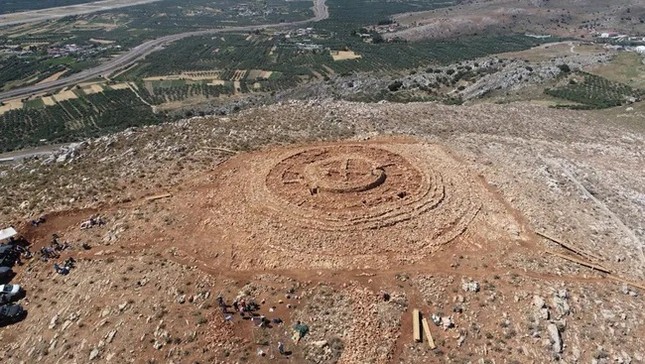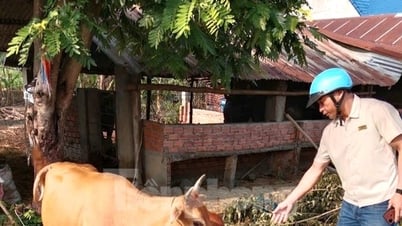TPO - Archaeologists in Crete, Greece have discovered a 4,000-year-old structure that the Minoans may have used for rituals.
 |
Panoramic view of the 4,000-year-old structure recently discovered on a hilltop in Kastelli, Greece. (Photo source: Greek Ministry of Culture) |
A 4,000-year-old circular structure discovered on a hilltop in Greece may have been used for ancient Minoan rituals, archaeologists say.
The structure consists of eight rings of stacked stones with small intersecting walls forming rooms, the building is almost a labyrinth, a representative of the Greek Ministry of Culture said in a statement on June 11, referring to the legendary labyrinth built for the Greek King Minos.
The unique structure, measuring 48 metres in diameter, was discovered some 51 kilometres southeast of Heraklion, the capital of Crete, while construction workers were installing a surveillance radar system for a new airport. Located on a hilltop near the town of Kastelli, the ancient building appears to have two main areas: a circular building measuring 15 metres in diameter in the centre and an area formed by radiating walls.
Based on the style of pottery fragments discovered during excavations, archaeologists estimate the building dates to between 2000 and 1700 BC, during the middle of the Minoan civilization. Between about 3000 and 1100 BC, the Minoans created one of the first complex European cultures on Crete – leaving behind examples of exquisite pottery, figurines, jewelry and frescoes.
After the collapse of this civilization, the Minoans were largely forgotten until archaeological work in the early 20th century by Sir Arthur Evans, who coined the term "Minoan" after the mythical king Minos.
The ancient palace of Knossos is the most famous example of Minoan architecture, with a central open space surrounded by dozens of smaller rooms connected by corridors. Although often referred to as “palaces,” these massive Minoan structures were primarily areas for local administration rather than royal residences.
According to a statement from the Ministry of Culture, the newly discovered building near Kastelli was also unlikely to have been used as a residence. Rather, the presence of numerous animal bones among other finds suggests periodic use of the building for community-wide ritual feasts that included food, wine, and other offerings.
According to Live Science
Source: https://tienphong.vn/phat-hien-cung-dien-bi-an-4000-nam-tuoi-voi-nhung-buc-tuong-nhu-me-cung-post1645938.tpo



![[Photo] 12th grade students say goodbye at the closing ceremony, preparing to embark on a new journey](https://vphoto.vietnam.vn/thumb/1200x675/vietnam/resource/IMAGE/2025/5/28/42ac3d300d214e7b8db4a03feeed3f6a)
![[Photo] Vietnamese and Hungarian leaders attend the opening of the exhibition by photographer Bozoky Dezso](https://vphoto.vietnam.vn/thumb/1200x675/vietnam/resource/IMAGE/2025/5/28/b478be84f13042aebc74e077c4756e4b)
![[Photo] Prime Minister Pham Minh Chinh receives a bipartisan delegation of US House of Representatives](https://vphoto.vietnam.vn/thumb/1200x675/vietnam/resource/IMAGE/2025/5/28/468e61546b664d3f98dc75f6a3c2c880)
![[Photo] General Secretary To Lam works with the Central Policy and Strategy Committee](https://vphoto.vietnam.vn/thumb/1200x675/vietnam/resource/IMAGE/2025/5/28/7b31a656d8a148d4b7e7ca66463a6894)




















































































Comment (0)